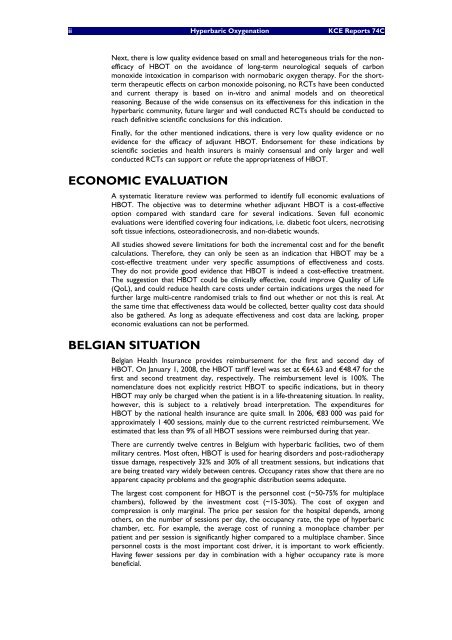Download the full report (130 p.)
Download the full report (130 p.)
Download the full report (130 p.)
You also want an ePaper? Increase the reach of your titles
YUMPU automatically turns print PDFs into web optimized ePapers that Google loves.
ii Hyperbaric Oxygenation KCE Reports 74C<br />
Next, <strong>the</strong>re is low quality evidence based on small and heterogeneous trials for <strong>the</strong> nonefficacy<br />
of HBOT on <strong>the</strong> avoidance of long-term neurological sequels of carbon<br />
monoxide intoxication in comparison with normobaric oxygen <strong>the</strong>rapy. For <strong>the</strong> shortterm<br />
<strong>the</strong>rapeutic effects on carbon monoxide poisoning, no RCTs have been conducted<br />
and current <strong>the</strong>rapy is based on in-vitro and animal models and on <strong>the</strong>oretical<br />
reasoning. Because of <strong>the</strong> wide consensus on its effectiveness for this indication in <strong>the</strong><br />
hyperbaric community, future larger and well conducted RCTs should be conducted to<br />
reach definitive scientific conclusions for this indication.<br />
Finally, for <strong>the</strong> o<strong>the</strong>r mentioned indications, <strong>the</strong>re is very low quality evidence or no<br />
evidence for <strong>the</strong> efficacy of adjuvant HBOT. Endorsement for <strong>the</strong>se indications by<br />
scientific societies and health insurers is mainly consensual and only larger and well<br />
conducted RCTs can support or refute <strong>the</strong> appropriateness of HBOT.<br />
ECONOMIC EVALUATION<br />
A systematic literature review was performed to identify <strong>full</strong> economic evaluations of<br />
HBOT. The objective was to determine whe<strong>the</strong>r adjuvant HBOT is a cost-effective<br />
option compared with standard care for several indications. Seven <strong>full</strong> economic<br />
evaluations were identified covering four indications, i.e. diabetic foot ulcers, necrotising<br />
soft tissue infections, osteoradionecrosis, and non-diabetic wounds.<br />
All studies showed severe limitations for both <strong>the</strong> incremental cost and for <strong>the</strong> benefit<br />
calculations. Therefore, <strong>the</strong>y can only be seen as an indication that HBOT may be a<br />
cost-effective treatment under very specific assumptions of effectiveness and costs.<br />
They do not provide good evidence that HBOT is indeed a cost-effective treatment.<br />
The suggestion that HBOT could be clinically effective, could improve Quality of Life<br />
(QoL), and could reduce health care costs under certain indications urges <strong>the</strong> need for<br />
fur<strong>the</strong>r large multi-centre randomised trials to find out whe<strong>the</strong>r or not this is real. At<br />
<strong>the</strong> same time that effectiveness data would be collected, better quality cost data should<br />
also be ga<strong>the</strong>red. As long as adequate effectiveness and cost data are lacking, proper<br />
economic evaluations can not be performed.<br />
BELGIAN SITUATION<br />
Belgian Health Insurance provides reimbursement for <strong>the</strong> first and second day of<br />
HBOT. On January 1, 2008, <strong>the</strong> HBOT tariff level was set at €64.63 and €48.47 for <strong>the</strong><br />
first and second treatment day, respectively. The reimbursement level is 100%. The<br />
nomenclature does not explicitly restrict HBOT to specific indications, but in <strong>the</strong>ory<br />
HBOT may only be charged when <strong>the</strong> patient is in a life-threatening situation. In reality,<br />
however, this is subject to a relatively broad interpretation. The expenditures for<br />
HBOT by <strong>the</strong> national health insurance are quite small. In 2006, €83 000 was paid for<br />
approximately 1 400 sessions, mainly due to <strong>the</strong> current restricted reimbursement. We<br />
estimated that less than 9% of all HBOT sessions were reimbursed during that year.<br />
There are currently twelve centres in Belgium with hyperbaric facilities, two of <strong>the</strong>m<br />
military centres. Most often, HBOT is used for hearing disorders and post-radio<strong>the</strong>rapy<br />
tissue damage, respectively 32% and 30% of all treatment sessions, but indications that<br />
are being treated vary widely between centres. Occupancy rates show that <strong>the</strong>re are no<br />
apparent capacity problems and <strong>the</strong> geographic distribution seems adequate.<br />
The largest cost component for HBOT is <strong>the</strong> personnel cost (~50-75% for multiplace<br />
chambers), followed by <strong>the</strong> investment cost (~15-30%). The cost of oxygen and<br />
compression is only marginal. The price per session for <strong>the</strong> hospital depends, among<br />
o<strong>the</strong>rs, on <strong>the</strong> number of sessions per day, <strong>the</strong> occupancy rate, <strong>the</strong> type of hyperbaric<br />
chamber, etc. For example, <strong>the</strong> average cost of running a monoplace chamber per<br />
patient and per session is significantly higher compared to a multiplace chamber. Since<br />
personnel costs is <strong>the</strong> most important cost driver, it is important to work efficiently.<br />
Having fewer sessions per day in combination with a higher occupancy rate is more<br />
beneficial.

















